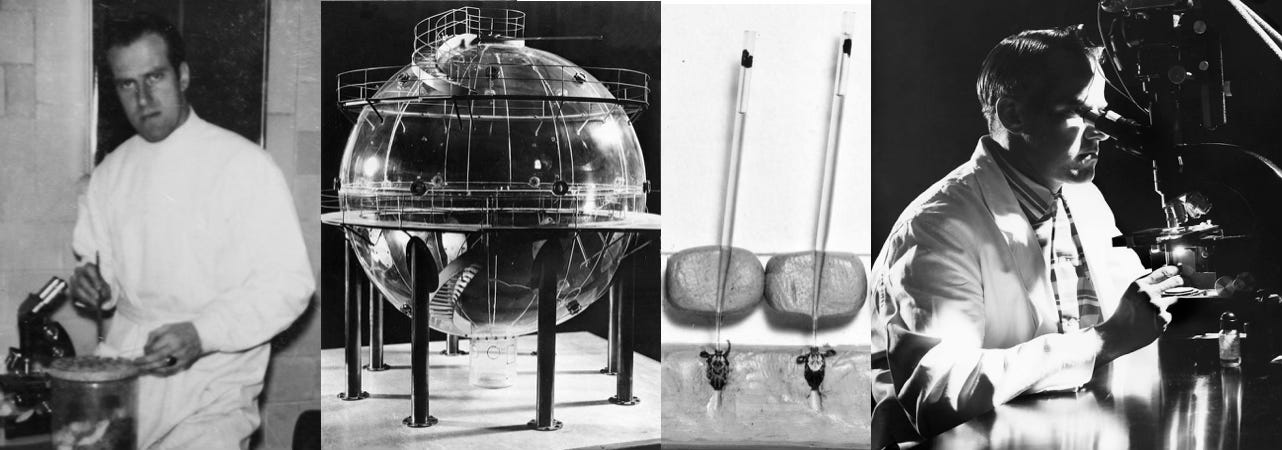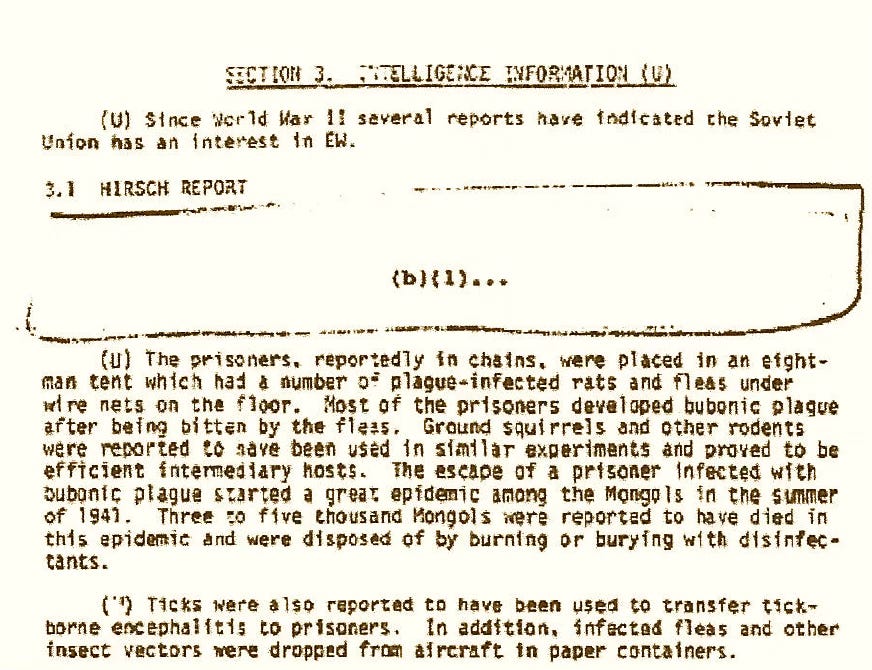After World War II, the U.S. military discovered that the Germans and Japanese had developed a variety of bug-borne bioweapons. The Germans experimented with malaria-infected mosquitoes [1], and the Japanese dropped plague-infected fleas and flies dusted with cholera bacteria on the Chinese. [2] What’s more, documents obtained by the CIA during the Cold War showed that the Soviets were conducting bioweapons-related experiments on ticks, including:
1. Exploring ways to get ticks to reproduce more rapidly.
2. Selectively crossbreeding tick species so they could carry disease agents that caused tick-borne encephalitis.
3. Dropping infected ticks from aircraft and balloons.
Intelligence reports on “Entomological Warfare (EW)” like this one stoked fear and paranoia in the Pentagon, and the Cold War bug-borne weapons race began. [3]
The U.S. entomological bioweapons program was directed by the Chemical Corps, headquartered at Fort Detrick, Maryland. The program was almost as large and secretive as the Manhattan Project to develop the atomic bomb. In 1951, Willy Burgdorfer, a medical zoologist with experience working with ticks and Q fever was recruited from Basel, Switzerland, to conduct feasibility studies for Fort Detrick. His lab was based in Rocky Mountain Laboratory in Hamilton, Montana, and it was home to the largest living tick collection in the U.S. Bugdorfer often traveled to Fort Detrick, where he translated and worked alongside Nazi biowarfare scientists who had been given immunity through Operation Paperclip. [4]
The Rocky Mountain Laboratory’s tick collection.
Weaponized insects (six-legged) and arthropods (eight-legged, like ticks) were considered the perfect stealth weapon. They could be dropped on enemy territory in advance of an air or land invasion to weaken the population and tie up medical resources. The Army elaborated on the military objective here:
In 1953 the Biological Warfare Laboratories at Fort Detrick established a program to study the use of arthropods [i.e. ticks] for spreading anti-personnel BW [bioweapons] agents. The advantages of arthropods as BW carriers are these: they inject the agent directly into the body, so that a mask is no protection to a soldier, and they will remain alive for some time, keeping an area constantly dangerous. [5]
Burgdorfer’s first assignment was figure out how to package fleas infected with plague in cardboard tubes so that they could be deployed in cluster bombs dropped from planes. Next, he experimentally determined the lethal dose of Trinidad yellow fever virus in artificially infected Aedes mosquitoes. And like the Soviets, he worked on ways to mass produce ticks, mosquitoes, and fleas.
One of his ongoing projects was to develop more efficient ways of artificially feeding ticks with potential biological agents. He did this by force-feeding them through glass capillary tubes containing agents for diseases such as Q fever (Coxiella burnetii), tularemia (Bacterium tularense), Weil’s disease (Leptospira icterohaemorrhagiae), Western equine encephalitis virus (family Togaviridae), epidemic typhus (Rickettsia prowazekii), Asiatic relapsing fever (Borrelia latychevi), Leptospirosis (Leptospira pomona), and the rabies virus. [6]
After thousands of experiments were conducted throughout the 50s and early 60s, the U.S. military decided that reliably and safely deploying bombs with two living organisms was nearly impossible, so this approach was abandoned in the early 60’s. My book BITTEN describes an incident where a CIA contractor dropped boxes of infected ticks on Cuban sugarcane workers from an airplane, and he brought back a “hitchhiker” that transmitted a near-fatal brain infection to his newborn.
The weaponized bug approach was replaced by Project 112, which included subprojects where biological agents were “brewed” in fermentation tanks, dried, then sprayed over large areas from planes, boats, buoys, or vehicles. Some of these biological agents (such as tularemia and Rickettsia rickettsii) could be spread by ticks after aerosol releases. Later in the 60s, as microbiological techniques became more sophisticated, bacteria and viruses were genetically combined/modified in military labs to make the agents more virulent, more undetectable, and/or untreatable by enemies.
There were many leak points and accidents in the weaponization process of these ticks and tick-borne diseases, which I will continue to publish in this space. These types of accidents can have long-lasting effects on the environment and human health, and this is why I continue to push for declassification of these decades-old military secrets. Knowledge of what got out in what locations will save lives and research dollars. And treatment strategies for diseases caused by genetically modified organisms may be different than treatments for naturally occurring pathogens.
This timeline shows U.S. biological weapons efforts in relationship with entomological weapons studies that Willy Burgdorfer conducted. (Sources available upon request.)
For more on Willy Burgdorfer and tick weaponization, read “BITTEN: The Secret History of Lyme Disease and Biological Weapons.”
###
Kris Newby is an award-winning medical science writer and the senior producer of the Lyme disease documentary UNDER OUR SKIN. Her book BITTEN: The Secret History of Lyme Disease and Biological Weapons won three international book awards for journalism and narrative nonfiction. Previously, Newby worked for Stanford Medical School, Apple, and other Silicon Valley companies.
If you've found this content useful, please consider supporting it through a small paid subscription. While my posts are free, your paid subscription helps underwrite this independent research. It also helps keep it free for those who cannot afford to pay.
CITATIONS
[1] Klaus Reinhardt, “The Entomological Institute of the Waffen-SS: evidence for offensive biological warfare research in the third Reich, Endeavour, Volume 37, Issue 4, 2013. https://doi.org/10.1016/j.endeavour.2013.05.001
[2] Lockwood, Jeffrey A. "Six-legged soldiers Archived 2010-05-22 at the Wayback Machine", The Scientist, October 24, 2008, accessed December 23, 2008.
[3] Rose, William H. Rose, “An Evaluation of Entomological Warfare as a Potential Danger to the United States and European NATO Nations,” U.S. Army Dugway Proving Ground, March 1981.
[4] Interview with Willy Burgdorfer conducted by Kris Newby.
[5] U.S. Army Chemical Corps, “Summary of Major Events and Problems (Fiscal Year 1959),” p. 100–104, https://www.osti.gov/opennet/servlets/purl/16006843-5BAfk6/16006843.pdf
[6] Burgdorfer W. Artificial feeding of ixodid ticks for studies on the transmission of disease agents. J Infect Dis. 1957 May-Jun;100(3):212-4. doi: 10.1093/infdis/100.3.212. PMID: 13439203.
###










Thanks Lauren! Keep up the good fight!
Nauseating. All of it is an abomination.